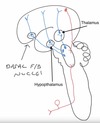The Brainstem and Consciousness (Reticular Formation) Flashcards
Define arousal
the emotional state associated with some kind of goal or avoidance of something noxious
Define consciousness
difficult to define but:
something to do with ‘awareness’ of both the external world and internal states
What two areas of the brain are requried for consciousness?
Cerebral Cortex + Reticular Formation

Where is the reticular formation located?
Located in the Brainstem
(diffuse structure/area)

What is the nature of the feedback loop between the cerebral cortex and reticular formation?
Positive Feedback Loop

Damage or lesions to which 3 areas of the brain can cause an altered level of consciousness?
Cerebral Cortex
Brainstem (reticular formation)
- *Conenctions Between Both**
- (e.g. in diffuse axonal injury)*
Which neurotransmitter is used by the excitatory neurones originating from the reticular formation to stimulate the subcortical nuclei?
Acetylcholine
(cirlces left to right:
basal F/B nuclei, hypothalamus, thalamus)

Which neurotransmitter is used from the neurones of the basal nuclei to excite the coertex?
Acetylcholine

Which neurotransmitter is used by the hypothalamic neuronal projections to the cortex, which help maintain consciousiness?
Histamine

What neurotransmitter is used by the thalamic projections to the cerebral cortex to help maintain consciousness?
Glutamate

How can anticholinergic drugs and anti-histamines cause drowsiness?
inhbit the positive/excitatory inputs from the reticular formation to the cerebral cortex
What scale is used to assess a patients level of consciousness?
Glasgow Coma Scale
(GCS)
What is measured by an electroencephalogram (EEG)?
combined activity of thousands of neurones
located to different geographical regions of the brain

What happens to the EEG waveform as you progress into deeper sleep?
decreasing frequency in firing
increasing amplitude as neuronal populations become synchronous
Which types of waves are found on an EEG when a person is awake?
Beta Waves

Irregular - up to 50Hz





